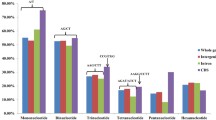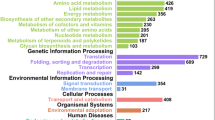Abstract
Microsatellite evolution normally occurs in diploids. Until now, there has been a lack of direct experimental evidence for microsatellite evolution following allopolyploidization. In the present study, F1 hybrids and newly synthesized allopolyploids were derived from Triticum aestivum Chinese Spring × Secale cereale Jinzhou-heimai. One hundred and sixty-three wheat simple sequence repeat (SSR) markers were used to investigate the variation of wheat microsatellites after allopolyploidization and variation of the PCR products of 29 of the SSR markers was observed. Of these 29 SSR markers, 15 were unable to produce products from amphiploids. The other 14 SSR markers did produce products from parental wheat, F1 hybrids and amphiploids. However, the length of the products amplified from amphiploids was different from the length of the products amplified from parental wheat and F1 hybrids. Sequencing indicated that the length variation of the 14 microsatellites stemmed mainly from variation in the number of repeat units. The alteration of repeat units occurred in both perfect and compound repeats. In some compound SSR loci, one motif was observed to expand whereas another to contract. Almost all the microsatellite evolution observed in this study could be explained by the slipped-strand mispairing model. The results of this study seem to indicate that stress caused by allopolyploidization might be one of the factors that induce microsatellite evolution. In addition, the findings of present study provided an instance of how simple sequence repeats evolved after allopolyploidization.







Similar content being viewed by others
References
Akkaya MS, Bhagwat AA, Cregan PB (1992) Length polymorphisms of simple sequence repeat DNA in soybean. Genetics 132:1131–1139
Azaiez A, Bouchard ÉF, Jean M, Belzile FJ (2006) Length, orientation, and plant host influence the mutation frequency in microsatellites. Genome 49:1366–1373
Bachtrog D, Agis M, Imhof M, Schlötterer C (2000) Microsatellite variability differs between dinucleotide repeat motifs-evidence from Drosophila melanogaster. Mol Biol Evol 17:1277–1285
Barrier M, Friar E, Robichaux R, Purugganan M (2000) Interspecific evolution in plant microsatellite structure. Gene 241:101–105
Beck NR, Double MC, Cockburn A (2003) Microsatellite evolution at two hypervariable loci revealed by extensive avian pedigrees. Mol Biol Evol 20:54–61
Beckmann JS, Soller M (1990) Toward a unified approach to genetic mapping of eukaryotes based on sequence tagged microsatellite sites. Biotechnology 8:30–32
Calabrese PP, Durrett RT, Aquadro CF (2001) Dynamics of microsatellite divergence under stepwise mutation and proportional slippage/point mutation models. Genetics 159:839–852
Cardle L, Ramsay L, Milbourne D, Macaulay M, Marshall D, Waugh R (2000) Computational and experimental characterization of physically clustered simple sequence repeats in plants. Genetics 156:847–854
Dettman JR, Taylor JW (2004) Mutation and evolution of microsatellite loci in neurospora. Genetics 168:1231–1248
Di Rienzo A, Peterson AC, Garza JC, Valdes AM, Slatkin M, Freimer NB (1994) Mutational processes of simple-sequence repeat loci in human populations. Proc Natl Acad Sci USA 91:3166–3170
Feldman M, Levy AA (2005) Allopolyploidy—a shaping force in the evolution of wheat genomes. Cytogenet Genome Res 109:250–258
Feldman M, Liu B, Segal G, Abbo S, Levy AA, Vega JM (1997) Rapid elimination of low-copy DNA sequences in polyploidy wheat: a possible mechanism for differentiation of homoeologous chromosomes. Genetics 147:1381–1387
Gáspári Z, Ortutay C, Tóth G (2007) Divergent microsatellite evolution in the human and chimpanzee lineages. FEBS Lett 581:2523–2526
Gaut BS, Doebley JF (1997) DNA sequence evidence for the segmental allotetraploid origin of maize. Proc Natl Acad Sci USA 94:6809–6814
Gómez MI, Islam-Faridi MN, Zwick MS, JrDG Czeschin, Hart GE, Wing RA, Stelly DM, Price HJ (1998) Tetraploid nature of Sorghum bicolor (L) Moench. J Hered 89:188–190
Harding RM, Boyce AJ, Clegg JB (1992) The evolution of tandemly repetitive DNA: recombination rules. Genetics 132:847–859
Innan H, Terauchi R, Miyashita NT (1997) Microsatellite polymorphism in natural population of the wild plant Arabidopsis thaliana. Genetics 146:1441–1452
Karaoglu H, Lee CMY, Meyer W (2005) Survey of simple sequence repeats in completed fungal genomes. Mol Biol Evol 22:639–649
Karhu A, Dieterich JH, Savolainen O (2000) Rapid expansion of microsatellite sequences in pines. Mol Biol Evol 17:259–265
Kashkush K, Feldman M, Levy AA (2002) Gene loss, silencing and activation in a newly synthesized wheat allotetraploid. Genetics 160:1651–1659
Katti MV, Ranjekar PK, Gupta VS (2001) Differential distribution of simple sequence repeats in eukaryotic genome sequences. Mol Biol Evol 18:1161–1167
Kubik C, Meyer WA, Gaut BS (1999) Assessing the abundance and polymorphism of simple sequence repeats in perennial ryegrass. Crop Sci 39:1136–1141
Lai Y, Sun F (2003) The relationship between microsatellite slippage mutation rate and the number of repeat units. Mol Biol Evol 20:2123–2131
Levinson G, Gutman GA (1987) Slipped-strand mispairing: a major mechanism for DNA sequence evolution. Mol Biol Evol 4:203–221
Levinson G, Marsh JL, Epplen JT, Gutman GA (1985) Cross-hybridizing snake satellite, Drosophila, and mouse DNA sequences may have arisen independently. Mol Biol Evol 2:494–504
Liu B, Vega JM, Feldman M (1998) Rapid genomic changes in newly synthesized amphiploids of Triticum and Aegilops. II. Changes in low-copy coding DNA sequences. Genome 41:535–542
López-Giráldez F, Marmi J, Domingo-Roura X (2007) High incidence of nonslippage mechanisms generating variability and complexity in Eurasian badger microsatellites. J Hered 98:620–628
Ma XF, Gustafson JP (2005) Genome evolution of allopolyploids: a process of cytological and genetic diploidization. Cytogenet Genome Res 109:236–249
Ma XF, Gustafson JP (2006) Timing and rate of genome variation in triticale following allopolyploidization. Genome 49:950–958
Ma XF, Fang P, Gustafson JP (2004) Polyploidization-induced genome variation in triticale. Genome 47:839–848
Madlung A, Comai L (2004) The effect of stress on genome regulation and structure. Ann Bot 94:481–495
Madlung A, Masuelli RW, Watson B, Reynolds SH, Davison J, Comai L (2002) Remodeling of DNA methylation and phenotypic and transcriptional changes in synthetic Arabidopsis allotetraploids. Plant Physiol 129:733–746
Makova KD, Nekrutenko A, Baker RJ (2000) Evolution of microsatellite alleles in four species of mices (genus Apodemus). J Mol Evol 51:166–172
Masterson J (1994) Stomatal size in fossil plants: evidence for polyploidy in the majority of angiosperms. Science 264:421–424
McClintock B (1978) Mechanisms that rapidly reorganize the genome. Stadler Genet Symp 10:25–48
Morgante M, Olivieri AM (1993) PCR amplified microsatellites in plant genetics. Plant J 3:175–182
Muravenko OV, Fedotov AR, Punina EO, Fedorova LI, Grif VG, Zelenin VA (1998) Comparison of chromosome BrdU-Hoechst-Giemsa banding patterns of the A(1) and (AD) (2) genomes of cotton. Genome 41:616–625
Ozkan H, Levy AA, Feldman M (2001) Allopolyploidy-induced rapid genome evolution in the wheat (Aegilops-Triticum) group. Plant Cell 13:1735–1747
Primmer CR, Ellegren H (1998) Patterns of molecular evolution in Avian microsatellites. Mol Biol Evol 15:997–1008
Röder MS, Korzun V, Wendehake K, Plaschke J, Tixier MH, Leroy P, Ganal MW (1998) A microsatellite map of wheat. Genetics 149:2007–2023
Shaked H, Kashkush K, Ozkan H, Feldman M, Levy AA (2001) Sequence elimination and cytosine methylation are rapid and reproducible responses of the genome to wide hybridization and allopolyploidy in wheat. Plant Cell 13:1749–1759
Shoemaker RC, Polzin K, Labate J, Specht J, Brummer EC, Olson T, Young N, Concibido V, Wilcox J, Tamulonis JP, Kochert G, Boerma HR (1996) Genome duplication in soybean (Glycine subgenus soja). Genetics 144:329–338
Song KM, Liu P, Tang KL, Osborn TC (1995) Rapid genome change in synthetic polyploids of Brassica and its implications for polyploid evolution. Proc Natl Acad Sci USA 92:7719–7723
Tang ZX, Fu SL, Ren ZL, Zhou JP, Yan BJ, Zhang HQ (2008) Variations of tandem repeat, regulatory element and promoter regions revealed by wheat–rye amphiploids. Genome 51:399–408
Taylor JS, Breden F (2000) Slipped-strand mispairing at noncontiguous repeats in poecilia reticulata: a model for minisatellite birth. Genetics 155:1313–1320
Thuillet AC, Bataillon T, Poirier S, Santoni S, David JL (2005) Estimation of long-term effective population sizes through the history of durum wheat using microsatellite data. Genetics 169:1589–1599
Toth G, Gaspari Z, Jurka J (2000) Microsatellites in different eukaryotic genomes: survey and analysis. Genome Res 10:967–981
Vigouroux Y, Jaqueth JS, Matsuoka Y, Smith OS, Beavis WD, Smith JSC, Doebley J (2002) Rate and pattern of mutation at microsatellite loci in maize. Mol Biol Evol 19:1251–1260
Vision TJ, Brown DG, Tanksley SD (2000) The origins of genomic duplications in Arabidopsis. Science 290:2114–2117
Wendel JF (2000) Genome evolution in polyploidy. Plant Mol Biol 42:225–249
Wong C, Weber JL (1993) Mutation of human short tandem repeats. Human Mol Genet 2:1123–1128
Zhang HB, Zhao XP, Ding X, Paterson AH, Wing RA (1995) Preparation of megabase-sized DNA from plant nuclei. Plant J 7:175–184
Zhivotovsky LA, Rosenberg NA, Feldman MW (2003) Features of evolution and expansion of modern humans, binferred from genomewide microsatellite markers. Am J Hum Genet 72:1171–1186
Zhu Y, Queller DC, Strassmann JE (2000) A phylogenetic perspective on sequence evolution in microsatellite loci. J Mol Evol 50:324–338
Acknowledgments
This study was supported by National Natural Science Foundation of China (Grant No. 30730065) and Youth Foundation of Sichuan Agriculture University (Grant No. 00131300). We also want to thank Kathleen Ross (USDA-ARS, University of Missouri, Columbia, MO, USA) for her linguistical revision of the manuscript.
Author information
Authors and Affiliations
Corresponding author
Rights and permissions
About this article
Cite this article
Tang, Z., Fu, S., Ren, Z. et al. Rapid Evolution of Simple Sequence Repeat Induced by Allopolyploidization. J Mol Evol 69, 217–228 (2009). https://doi.org/10.1007/s00239-009-9261-2
Received:
Revised:
Accepted:
Published:
Issue Date:
DOI: https://doi.org/10.1007/s00239-009-9261-2




